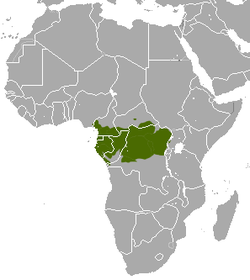Habits
The crested mona monkey is a highly vocal species with a wide repertoire of calls. Both males and females have vocal sacs which are inflated to be used as resonators. A typical call is the booming call made by the adult male which can be heard more than 200m away. Social interactions include tail twining between resting monkeys and a ritualised head display. [4]
The crested mona monkey is an agile species, which crosses large gaps between trees by jumping. They are normally found in groups of between 8 and 20 individuals which are typically made up of a single male, several females and their dependent offspring. Groups are highly vocal, with the males producing the loud, "boom" mentioned above announcing their presence and status, there is also a sharp hacking call which is used as an alarm. The dominant males are able to establish groups, and therefore the lives of most males are rather solitary and are marked by an absence of social contact. Surprisingly, this appears to lead to some males joining groups of other monkeys such as the black colobus Colobus satanas, where these solitary males can form strong group bonds with the non conspecific monkeys, possibly resulting in a permanent loss of mating opportunities. The social groups of crested mona monkeys will also associate with other guenon species, especially with moustached guenon Cercopithecus cephus and greater spot-nosed monkey Cercopithecus nictitans. In the Atlantic coastal forests, this includes red-capped mangabey as well. These large mixed-species groups grant the monkeys' increased protection from predation, as the greater number of eyes on the sky means that the spotting of predators such as birds of prey is more likely, and it also facilitates the sharing of information between groups about the best foraging sites. [5]
The crested mona monkey is mainly frugivorous but invertebrates are also frequently taken, along with small quantities of leaves. Unlike most guenons, populations of the crested mona monkey in the northern parts of its range are known to migrate over long distances to forage for seasonally abundant food supplies. The crested mona monkey has a polygynous mating system where the dominant male in each group has exclusive breeding access to all the females in that group. Breeding seem to take place at any time of year, and the females give birth to a single baby after a gestation period of roughly five months. [5]
This page is based on this
Wikipedia article Text is available under the
CC BY-SA 4.0 license; additional terms may apply.
Images, videos and audio are available under their respective licenses.


